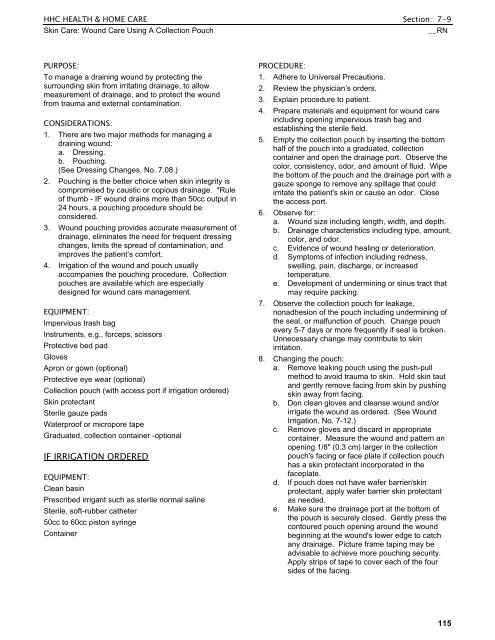HHC Health & Home Care Clinical Policy And
HHC Health & Home Care Clinical Policy And
HHC Health & Home Care Clinical Policy And
You also want an ePaper? Increase the reach of your titles
YUMPU automatically turns print PDFs into web optimized ePapers that Google loves.
<strong>HHC</strong> HEALTH & HOME CARE Section: 7-9<br />
Skin <strong>Care</strong>: Wound <strong>Care</strong> Using A Collection Pouch __RN<br />
PURPOSE:<br />
To manage a draining wound by protecting the<br />
surrounding skin from irritating drainage, to allow<br />
measurement of drainage, and to protect the wound<br />
from trauma and external contamination.<br />
CONSIDERATIONS:<br />
1. There are two major methods for managing a<br />
draining wound:<br />
a. Dressing.<br />
b. Pouching.<br />
(See Dressing Changes, No. 7.08.)<br />
2. Pouching is the better choice when skin integrity is<br />
compromised by caustic or copious drainage. *Rule<br />
of thumb - IF wound drains more than 50cc output in<br />
24 hours, a pouching procedure should be<br />
considered.<br />
3. Wound pouching provides accurate measurement of<br />
drainage, eliminates the need for frequent dressing<br />
changes, limits the spread of contamination, and<br />
improves the patient’s comfort.<br />
4. Irrigation of the wound and pouch usually<br />
accompanies the pouching procedure. Collection<br />
pouches are available which are especially<br />
designed for wound care management.<br />
EQUIPMENT:<br />
Impervious trash bag<br />
Instruments, e.g., forceps, scissors<br />
Protective bed pad<br />
Gloves<br />
Apron or gown (optional)<br />
Protective eye wear (optional)<br />
Collection pouch (with access port if irrigation ordered)<br />
Skin protectant<br />
Sterile gauze pads<br />
Waterproof or micropore tape<br />
Graduated, collection container -optional<br />
IF IRRIGATION ORDERED<br />
EQUIPMENT:<br />
Clean basin<br />
Prescribed irrigant such as sterile normal saline<br />
Sterile, soft-rubber catheter<br />
50cc to 60cc piston syringe<br />
Container<br />
PROCEDURE:<br />
1. Adhere to Universal Precautions.<br />
2. Review the physician’s orders.<br />
3. Explain procedure to patient.<br />
4. Prepare materials and equipment for wound care<br />
including opening impervious trash bag and<br />
establishing the sterile field.<br />
5. Empty the collection pouch by inserting the bottom<br />
half of the pouch into a graduated, collection<br />
container and open the drainage port. Observe the<br />
color, consistency, odor, and amount of fluid. Wipe<br />
the bottom of the pouch and the drainage port with a<br />
gauze sponge to remove any spillage that could<br />
irritate the patient's skin or cause an odor. Close<br />
the access port.<br />
6. Observe for:<br />
a. Wound size including length, width, and depth.<br />
b. Drainage characteristics including type, amount,<br />
color, and odor.<br />
c. Evidence of wound healing or deterioration.<br />
d. Symptoms of infection including redness,<br />
swelling, pain, discharge, or increased<br />
temperature.<br />
e. Development of undermining or sinus tract that<br />
may require packing.<br />
7. Observe the collection pouch for leakage,<br />
nonadhesion of the pouch including undermining of<br />
the seal, or malfunction of pouch. Change pouch<br />
every 5-7 days or more frequently if seal is broken.<br />
Unnecessary change may contribute to skin<br />
irritation.<br />
8. Changing the pouch:<br />
a. Remove leaking pouch using the push-pull<br />
method to avoid trauma to skin. Hold skin taut<br />
and gently remove facing from skin by pushing<br />
skin away from facing.<br />
b. Don clean gloves and cleanse wound and/or<br />
irrigate the wound as ordered. (See Wound<br />
Irrigation, No. 7-12.)<br />
c. Remove gloves and discard in appropriate<br />
container. Measure the wound and pattern an<br />
opening 1/8" (0.3 cm) larger in the collection<br />
pouch's facing or face plate if collection pouch<br />
has a skin protectant incorporated in the<br />
faceplate.<br />
d. If pouch does not have wafer barrier/skin<br />
protectant, apply wafer barrier skin protectant<br />
as needed.<br />
e. Make sure the drainage port at the bottom of<br />
the pouch is securely closed. Gently press the<br />
contoured pouch opening around the wound<br />
beginning at the wound's lower edge to catch<br />
any drainage. Picture frame taping may be<br />
advisable to achieve more pouching security.<br />
Apply strips of tape to cover each of the four<br />
sides of the facing.<br />
115







